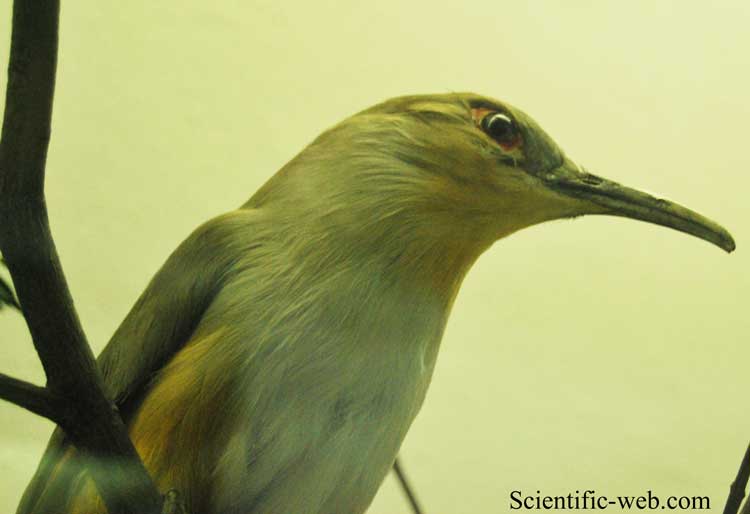
Coccyzus vetula, Photo: Michael Lahanas
Superregnum: Eukaryota
Cladus: Unikonta
Cladus: Opisthokonta
Cladus: Holozoa
Regnum: Animalia
Subregnum: Eumetazoa
Cladus: Bilateria
Cladus: Nephrozoa
Superphylum: Deuterostomia
Phylum: Chordata
Subphylum: Vertebrata
Infraphylum: Gnathostomata
Megaclassis: Osteichthyes
Cladus: Sarcopterygii
Cladus: Rhipidistia
Cladus: Tetrapodomorpha
Cladus: Eotetrapodiformes
Cladus: Elpistostegalia
Superclassis: Tetrapoda
Cladus: Reptiliomorpha
Cladus: Amniota
Classis: Reptilia
Cladus: Eureptilia
Cladus: Romeriida
Subclassis: Diapsida
Cladus: Sauria
Infraclassis: Archosauromorpha
Cladus: Crurotarsi
Divisio: Archosauria
Cladus: Avemetatarsalia
Cladus: Ornithodira
Subtaxon: Dinosauromorpha
Cladus: Dinosauriformes
Cladus: Dracohors
Cladus: Dinosauria
Ordo: Saurischia
Cladus: Eusaurischia
Subordo: Theropoda
Cladus: Neotheropoda
Cladus: Averostra
Cladus: Tetanurae
Cladus: Avetheropoda
Cladus: Coelurosauria
Cladus: Tyrannoraptora
Cladus: Maniraptoromorpha
Cladus: Maniraptoriformes
Cladus: Maniraptora
Cladus: Pennaraptora
Cladus: Paraves
Cladus: Eumaniraptora
Cladus: Avialae
Infraclassis: Aves
Cladus: Euavialae
Cladus: Avebrevicauda
Cladus: Pygostylia
Cladus: Ornithothoraces
Cladus: Ornithuromorpha
Cladus: Carinatae
Parvclassis: Neornithes
Cohors: Neognathae
Cladus: Neoaves
Ordo: Cuculiformes
Familia: Cuculidae
Genus: Coccyzus
Species: Coccyzus vetula
Name
Coccyzus vetula (Linnaeus, 1758)
Synonyms
Cuculus vetula (protonym)
Saurothera vetula (Linnaeus, 1758)
References
Linnaeus, C. 1758. Systema Naturae per regna tria naturae, secundum classes, ordines, genera, species, cum characteribus, differentiis, synonymis, locis. Editio Decima, Reformata. Tomus I. Holmiæ (Stockholm): impensis direct. Laurentii Salvii. 824 pp. DOI: 10.5962/bhl.title.542 BHL p. 111 BHL Reference page.
Vernacular names
English: Jamaican Lizard Cuckoo
français: Tacco de Jamaïque
italiano: Coccyzus vetula
Türkçe: Jamaika kertenkele guguğu
The Jamaican lizard cuckoo (Coccyzus vetula) is a species of bird in the tribe Phaenicophaeini, subfamily Cuculinae of the cuckoo family Cuculidae. It is endemic to Jamaica.[2][3]
Taxonomy and systematics
The Jamaican lizard cuckoo and three other lizard cuckoos were for a time considered a single species. Individually they were previously placed in genus Saurothera that was later merged into the current Coccyzus, and they are considered a superspecies.[4] The Jamaican lizard cuckoo is monotypic.[2]
Description
The Jamaican lizard cuckoo is 38 to 40 cm (15 to 16 in) long, about half of which is the tail, and weighs 86 to 105 g (3.0 to 3.7 oz). It has a long, straight, rectangular bill with a black maxilla and a paler mandible. The sexes have the same plumage. Adults have a brown forehead, crown to below the eye, and nape. Their upperparts are grayish with rufous primaries. Their throat is whitish and the rest of the underparts are rufous that is lighter on the undertail coverts. Their tail feathers are gray with wide white tips; the central pair have a black band above the tip. Their eye is surrounded by bare red skin. Juveniles have narrower tail feathers than adults and buffy tips on the secondaries.[5]
Distribution and habitat
The Jamaican lizard cuckoo is found throughout the island from sea level to 1,200 m (3,900 ft) of elevation. It primarily inhabits lowland tropical evergreen forest and is also found in tropical deciduous forest, more open woodlands, and semi-arid landscapes of trees and shrubs.[5]
Behavior
Movement
The Jamaican lizard cuckoo is not migratory.[5]
Feeding
The Jamaican lizard cuckoo forages mostly from the forest mid-story to the canopy, running along branches and gliding from tree to tree. Its diet is cosmopolitan and includes Anolis lizards, adult and larval insects, mice, nestling birds, and sometimes tree frogs. Young are fed mainly with lizards.[5]
Breeding
The Jamaican lizard cuckoo's breeding season generally spans from March to August, though courtship has been observed in October. It makes a flat platform nest of twigs lined with leaves, placed well hidden in a tangle of branches or bromeliads. Both adults incubate the eggs and care for nestlings.[5]
Dickcissel male perched on a metal pole singing, with neck stretched and beak open.
Songs and calls
Listen to Jamaican lizard cuckoo on xeno-canto
Vocalization
The Jamaican lizard cuckoo's principal vocalization is a "[r]apid, low 'cak-cak-cak-ka-ka-ka-k-k'."[5]
Status
The IUCN has assessed the Jamaican lizard cuckoo as being of Least Concern, though it has a rather small range and an unknown population size that is believed to be decreasing. No immediate threats have been identified.[1] It is widespread on the island but uncommon, and "further research is required to determine various aspects of its breeding."[5]
References
BirdLife International (2018). "Jamaican Lizard-cuckoo Coccyzus vetula". IUCN Red List of Threatened Species. 2018: e.T22684399A130096625. doi:10.2305/IUCN.UK.2018-2.RLTS.T22684399A130096625.en. Retrieved 26 September 2022.
Gill, F.; Donsker, D.; Rasmussen, P., eds. (August 2022). "Turacos, bustards, cuckoos, mesites, sandgrouse". IOC World Bird List. v 12.2. Retrieved August 8, 2022.
HBW and BirdLife International (2021) Handbook of the Birds of the World and BirdLife International digital checklist of the birds of the world. Version 6. Available at: http://datazone.birdlife.org/userfiles/file/Species/Taxonomy/HBW-BirdLife_Checklist_v6_Dec21.zip retrieved August 7, 2022
"Check-list of North and Middle American Birds". American Ornithological Society. August 2022. Retrieved August 9, 2022.
Payne, R. B. (2020). Jamaican Lizard-Cuckoo (Coccyzus vetula), version 1.0. In Birds of the World (J. del Hoyo, A. Elliott, J. Sargatal, D. A. Christie, and E. de Juana, Editors). Cornell Lab of Ornithology, Ithaca, NY, USA. https://doi.org/10.2173/bow.jamlic1.01 retrieved September 26, 2022
Further reading
Wikimedia Commons has media related to Coccyzus vetula.
Raffaele, Herbert; James Wiley, Orlando Garrido, Allan Keith & Janis Raffaele (2003) Birds of the West Indies, Christopher Helm, London.
Retrieved from "http://en.wikipedia.org/"
All text is available under the terms of the GNU Free Documentation License

